Characterization of Serpentines from Different Regions by Transmission Electron Microscopy, X-ray Diffraction, BET Specific Surface Area and Vibrational and Electronic Spectroscopy
Abstract
1. Introduction
2. Materials and Methods
3. Results and Discussion
3.1. Petrographic Studies
3.2. Scanning Electron Micrographs (SEM)
3.3. X-ray Diffraction
3.4. Surface Area and Porosity
3.5. DR-UV-Vis Spectroscopy
3.6. FT-IR Spectroscopy
4. Implications of the Serpentinites
Author Contributions
Funding
Acknowledgments
Conflicts of Interest
References
- Wicks, F.J.; O’Hanley, D.S. Serpentine Mineral: Structure and petrology. Reviews in Mineralogy. In Hydrous Phylosilicates; Baley, S.W., Ed.; Mineralogical Society of America: Chantilly, VA, USA, 1988; pp. 91–167. [Google Scholar]
- Andreani, M.; Mevel, C.; Boulier, A.M.; Escertín, J. Dynamic control on serpentine crystallisation in veins: Contrainints on hydration process in oceanic peridotites. Geochem. Geophys. Geosyst. 2007, 8. [Google Scholar] [CrossRef]
- Dicchico, M.C.; Paternoster, M.; Rizzo, G.; Sinisi, R. Mineralogical Asbesto Assessment in the Southern Appenines (Italy): A review. Fibers 2019, 7, 24. [Google Scholar] [CrossRef]
- Auzende, A.L.; Devouard, B.S.; Danile, I.; Baronnet, A.; Lardeaux, J.M. Serpentines from Central Cuba: Petrology and HRSEM study. Eur. J. Mineral. 2002, 14, 905–914. [Google Scholar] [CrossRef]
- Evans, B.W. The serpentinite multisysSEM revisited: Chrysotile is metastable. Int. Geol. Rev. 2004, 46, 479–506. [Google Scholar] [CrossRef]
- Cressey, B.A.; Whittaker, E.J.W. Five-fold symmetry in chrysotile asbestos revealed by transmission electron microscopy. Mineral. Mag. 1993, 5, 729–732. [Google Scholar] [CrossRef][Green Version]
- Pereira, D.; Yenes, M.; Blanco, J.A.; Peinado, M. Characterization of serpentinites to define their appropriate use as dimension stone. Geol. Soc. Lond. Spec. Publ. 2007, 271, 55–62. [Google Scholar] [CrossRef]
- Pereira, D.; Peinado, M.; Blanco, J.A.; Yenes, M. Geochemical characterization of a serpentinization process at Cabo Ortegal (NW Spain). Can. Mineral. 2008, 46, 317–327. [Google Scholar] [CrossRef]
- Pereira, D.; Peinado, M.; Yenes, M.; Monterrubio, S.; Nespereira, J.; Blanco, J.A. Serpentinites from Cabo Ortegal (Galicia, Spain): A search for correct use as ornamental stones. Geol. Soc. Lond. Spec. Publ. 2010, 333, 81–85. [Google Scholar] [CrossRef]
- Post, J.L.; Borer, L. High-resolution infrared spectra, physical properties, and micromorphology of serpentines. Appl. Clay Sci. 2000, 16, 73–85. [Google Scholar] [CrossRef]
- Navarro, R.; Pereira, D.; Gimeno, A.; del Barrio, S. Verde Macael: A serpentinite wrongly referred to as a marble. Geosciences 2013, 3, 102–113. [Google Scholar] [CrossRef]
- Navarro, R.; Pereira, D.; Rodríguez-Navarro, C.; Sebastián Pardo, E. The Sierra Nevada Serpentinites: The serpentinites most used in Spanish Heritage buildings. Geol. Soc. Lond. Spec. Publ. 2015, 407, 38–44. [Google Scholar] [CrossRef]
- CHEKCELL.v.2. Program of Refinement Software by Jean Lauguier et Bernard Bochu. Available online: http://www.inpg.fr/LMGP or Http://www.ccp14.ac.uk/tutorial/Imgp/ (accessed on 29 April 2019).
- West, A.R. Solid State Chemistry and Its Applications; Wiley: Chichester, UK, 1996; p. 174. [Google Scholar]
- Liu, K.; Chen, Q.; Hu, H.; Yin, Z. Characterization and leaching behaviour of lizardite in Yuanjiang laterite ore. Appl. Clay Sci. 2010, 47, 311–316. [Google Scholar] [CrossRef]
- Li, W.; Huang, Z.; Liu, Y.; Fang, M.; Ouyang, X.; Huang, S. Phase behavior of serpentine mineral by carbothermal reduction nitridation. Appl. Clay Sci. 2012, 57, 86–90. [Google Scholar] [CrossRef]
- Gregg, S.J.; Sing, K.S.W. Adsorption Surface Area and Porosity; Academic Press: London, UK, 1991. [Google Scholar]
- Barry, C.; Norton, M.G. Ceramic Materials: Science and Engineering; Springer: New York, NY, USA, 2007. [Google Scholar]
- Haar De, L.G.J.; Blase, G. Photoelectrochemical properties of MgTiO3 and other titanates with the ilmenite structure. J. Electrochem. Soc. 1985, 132, 2933. [Google Scholar] [CrossRef]
- Willey, R.J.; Oliveri, S.A.; Busca, G. Structure and magnetic properties of magnesium ferrite fine powdersStructure and magnetic properties of magnesium ferrite fine powders. J. Mater. Res. 1993, 8, 1418–1427. [Google Scholar] [CrossRef]
- Prieto García, M.C.; Gallardo Amores, J.M.; Sánchez Escribano, V.; Busca, G. Characterization of coprecipitated Fe2O3-Al2O3 powders. J. Mater. Chem. 1994, 4, 1123–1130. [Google Scholar] [CrossRef]
- Kennedy, J.H.; Frese, K.W. Photooxidation of water at α-Fe2O3 electrodes. J. Electrochem. Soc. 1978, 125, 709. [Google Scholar] [CrossRef]
- Busca, G.; Ramis, G.; Prieto García, M.C.; Sánchez Escribano, V. Preparation and characterization of Fe2−xCrxO3 mixed oxide powders. J. Mater. Chem. 1993, 3, 665–673. [Google Scholar] [CrossRef]
- Mazza, D.; Lucco-Borlera, M.; Busca, G.; Delmastro, A. High-quartz solid-solution phases from xerogels with composition 2MgO.2Al2O3.5SiO2 μ-cordierite. J. Eur. Ceram. Soc. 1993, 11, 299–308. [Google Scholar] [CrossRef]
- Bellamy, L.J. The Infrared Spectra of Complex Molecules, 3rd ed.; John Wiley and Sons, Inc.: New York, NY, USA, 1975. [Google Scholar]
- Foresti, E.; Formaro, E.; Lesci, I.G.; Zuccheri, R.T.; Roveri, N. Asbestos health hazard: A spectroscopic study of synthetic geoinspired Fe-doped chrysotile. J. Hazard. Mater. 2009, 167, 1070–1079. [Google Scholar] [CrossRef]
- Frost Ray, L.; Jagannadha Reddy, B.; Bahfenne, S.; Graham, J. Mid-infrared and near-infrared spectroscopic study of selected magnesium carbonate minerals containing ferric iron-Implications for the geosequestration of greenhouse gases. Spectrochem. Acta Part A Mol. Biomol. Spectrosc. 2009, 72, 597–604. [Google Scholar] [CrossRef]
- Gadsden, J.A. Infrared Spectra of Minerals and Related Inorganic Compounds; Butterworths: London, UK, 1975. [Google Scholar]
- Griffith, W.P. Spectroscopy of Inorganic-Based Materials; Clark, R.J.H., Hester, R.E., Eds.; Wiley: Hoboken, NZ, USA, 1987. [Google Scholar]
- Astorino, E.; Peri, J.B.; Willey, R.J.; Busca, G. Spectroscopic characterization of silicate-1 and titanium silicate-1. J. Catal. 1995, 157, 482–500. [Google Scholar] [CrossRef]
- Kamitsos, E.I.; Patsis, A.P.; Kordas, G. Infrared-reflectance spectra of heat-treated sol-gel-derived silica. Phys. Rev. B 1993, 48, 12499. [Google Scholar] [CrossRef]
- Montanari, T.; Gastaldi, L.; lietti, L.; Busca, G. Basic catalysis and catalysis assisted by basicity: FT-IR and TPD characterization of potassium-doped alumina. Appl. Catal. A Gen. 2011, 400, 61–69. [Google Scholar] [CrossRef]
- Dicchico, M.C.; de Bonis, A.; Mongelli, G.; Rizzo, G.; Sinisi, R. μ-Raman spectroscopy and X-ray diffraction of asbestos minerals for geoenvironmental monitoring: The case of the southern Appenines natural sources. Appl. Clay Sci. 2017, 141, 292–299. [Google Scholar] [CrossRef]
- Dicchico, M.C.; Laurita, S.; Sinisi, R.; Battiloro, R.; Rizzo, G. Environmental and Health: The importance of tremolite occurence in the Pollino Geopark (Southern Italy). Geosciences 2018, 8, 98. [Google Scholar] [CrossRef]
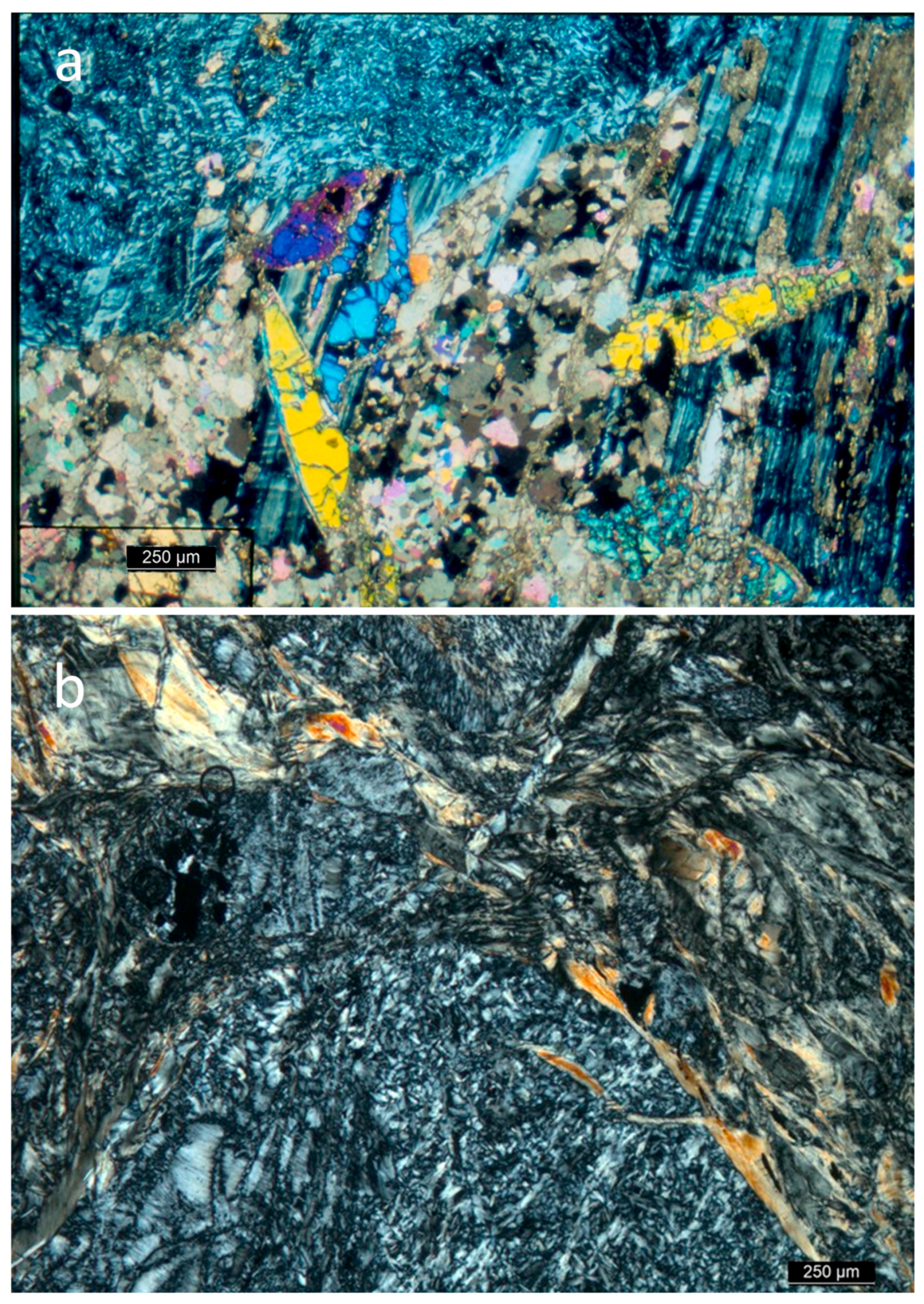
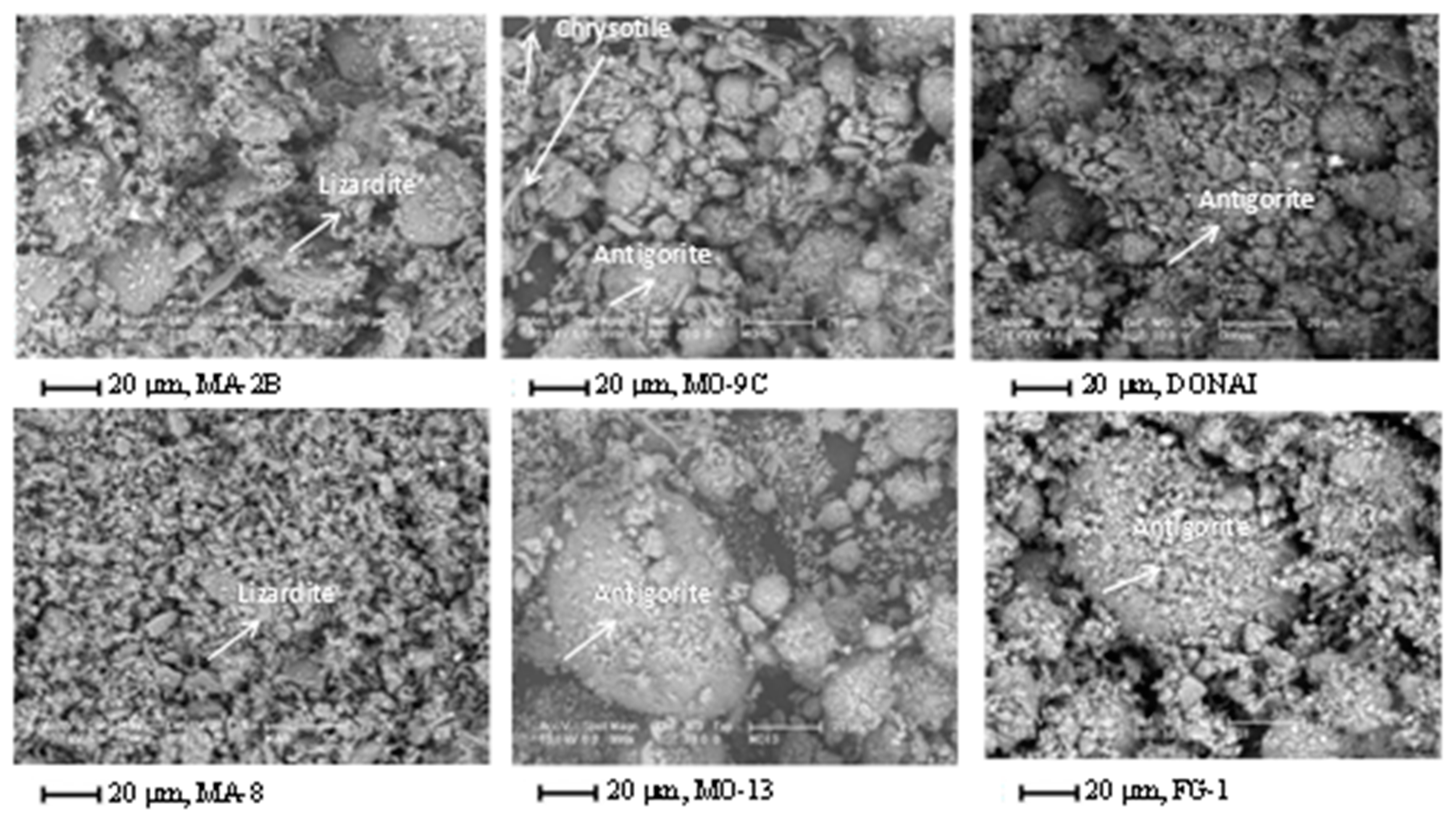

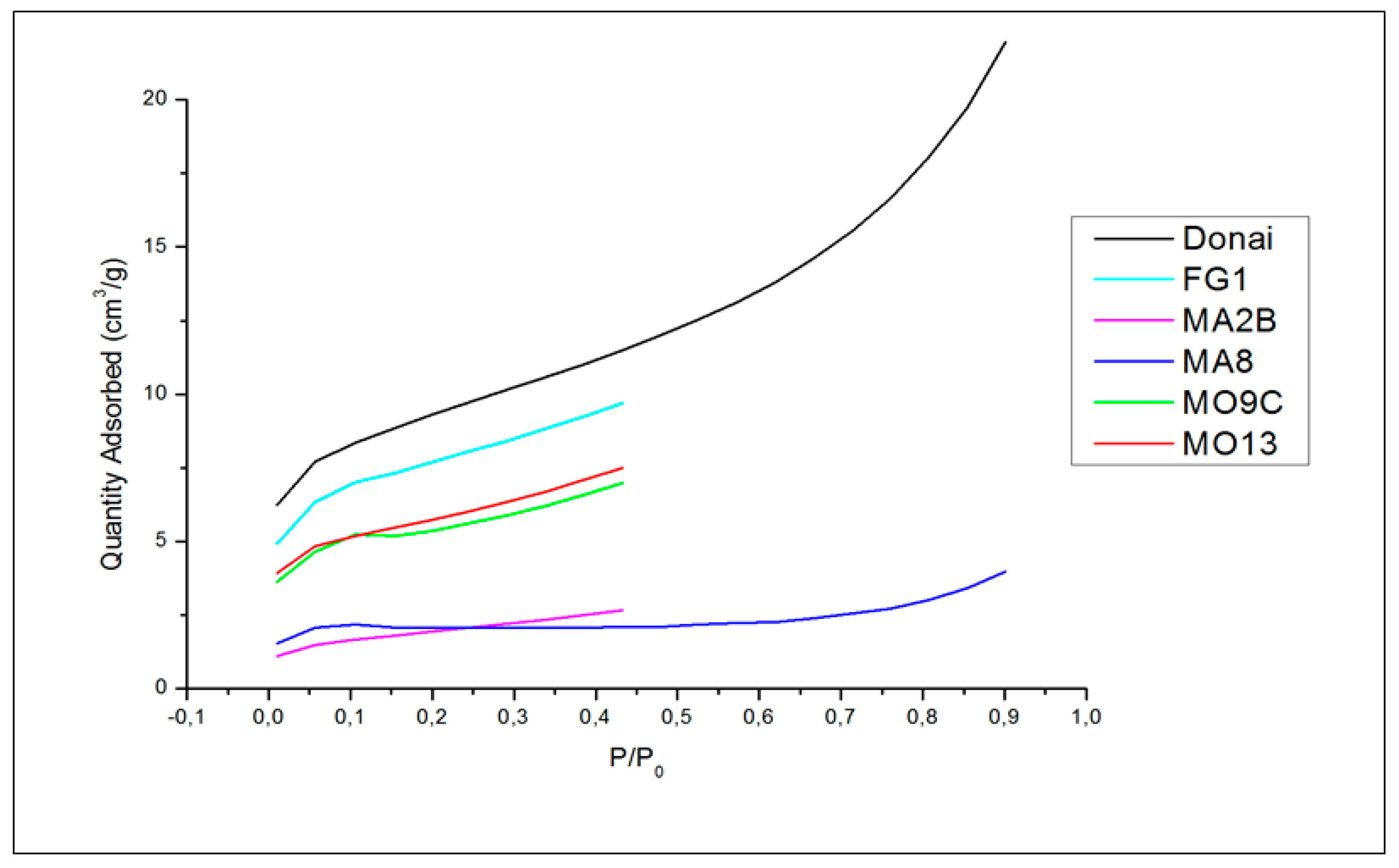
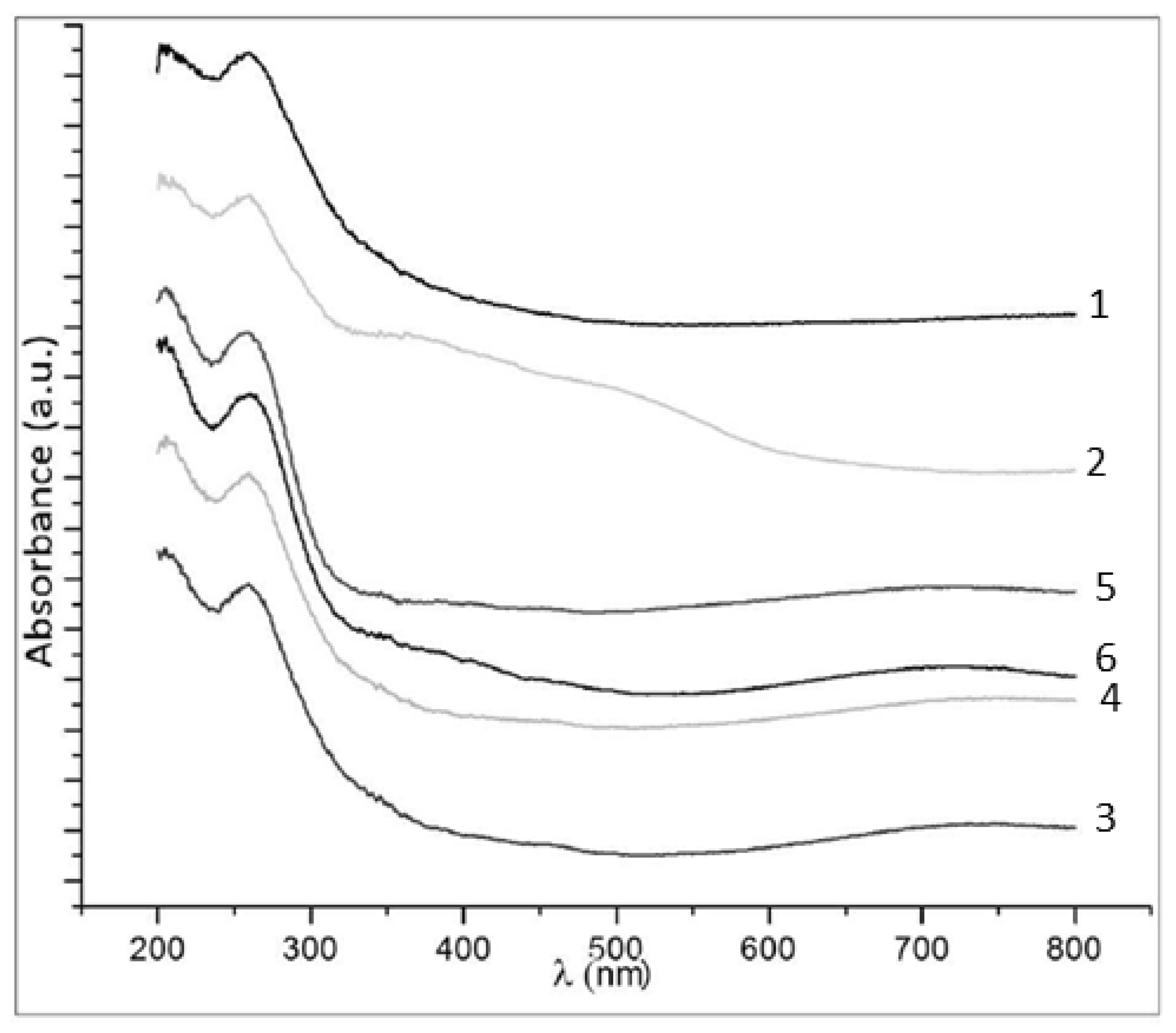
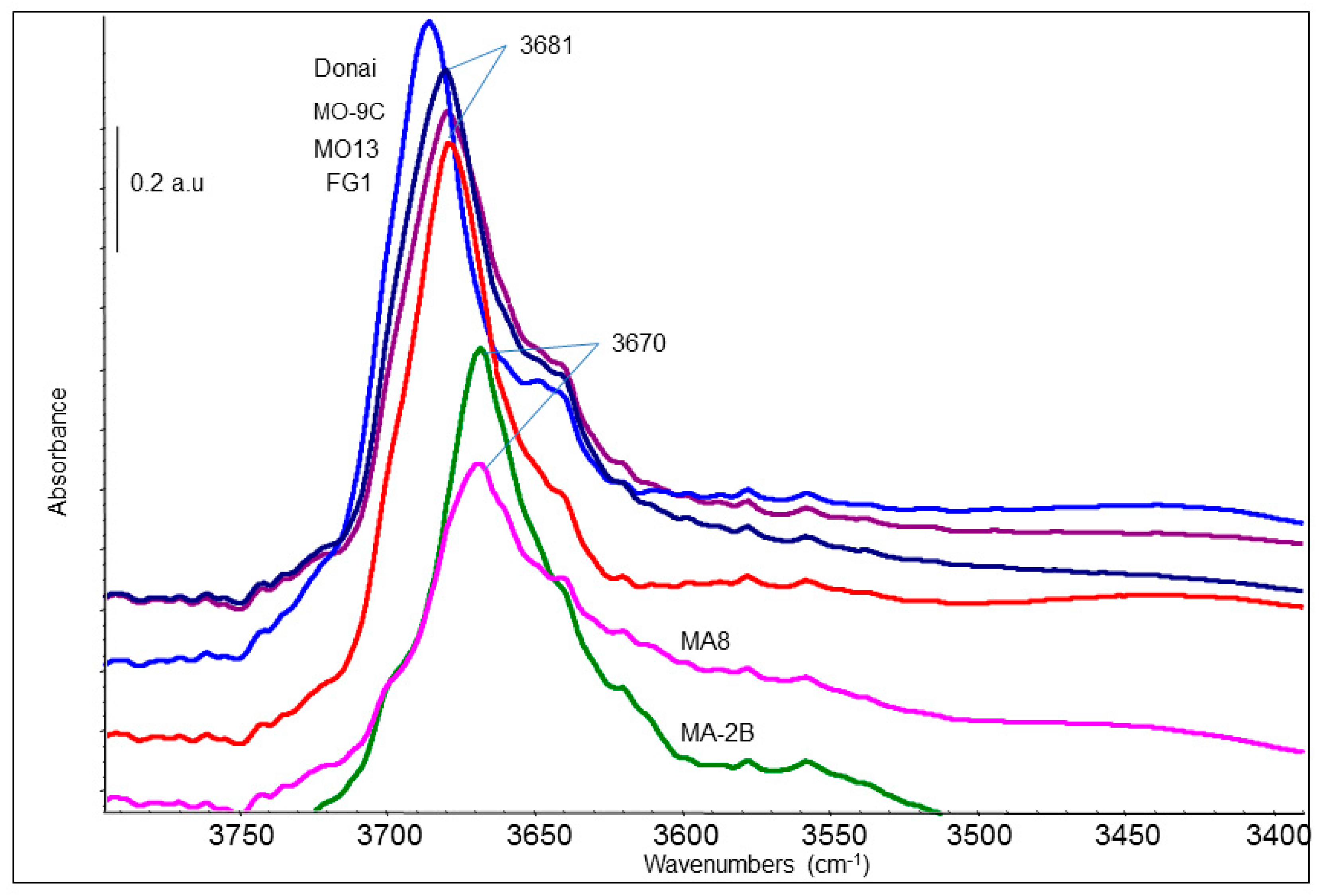
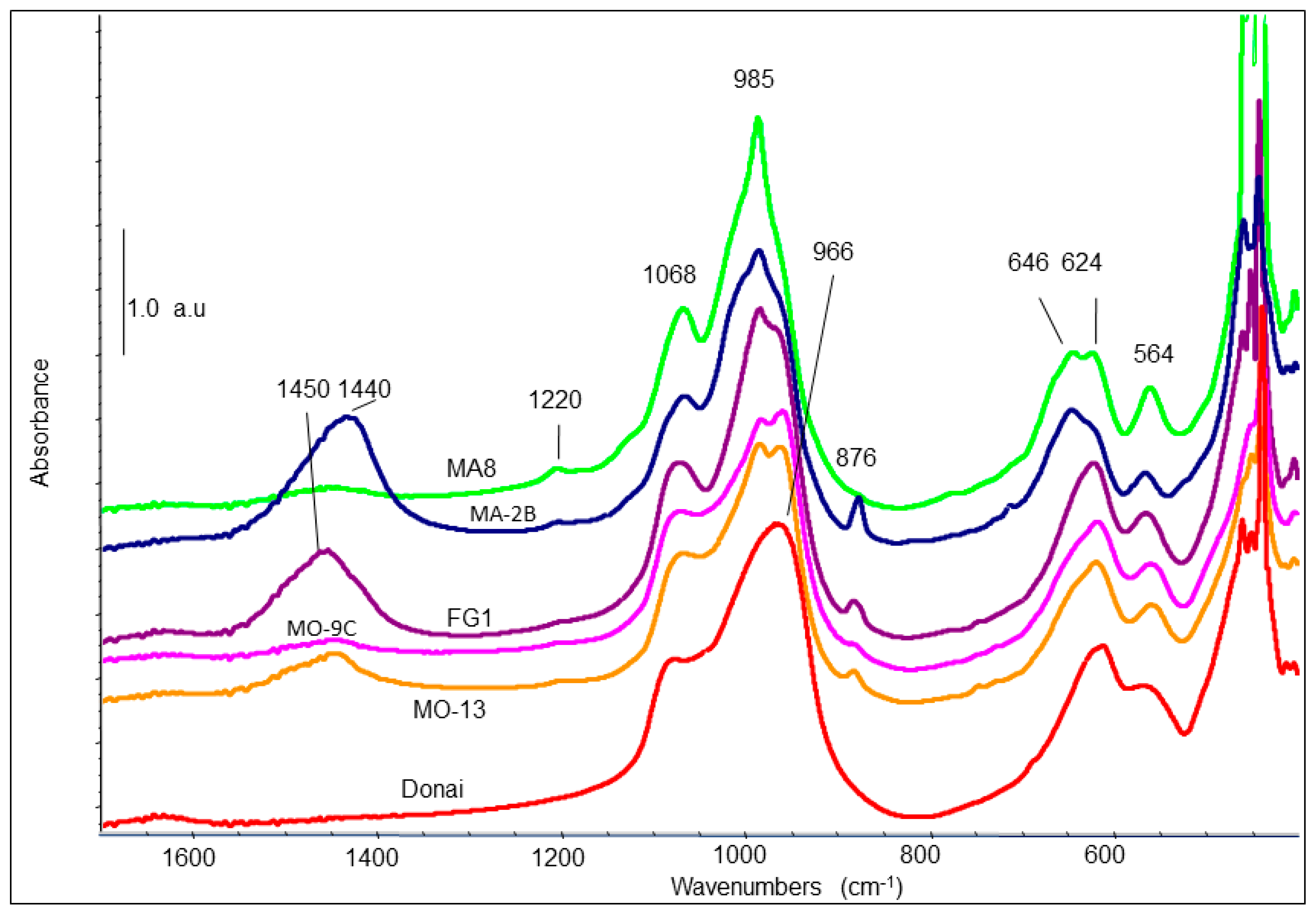
| Sample | Mineral Phase | Cell Paramaters(Å) | V(Å3) | D(Å) | SBET (m2∙g−1) | ||
|---|---|---|---|---|---|---|---|
| A(Å) | B(Å) | C(Å) | |||||
| MA8 | Lizardite, calcite, dolomite, magnetite | 5.335(3) | 5.335(3) | 7.335(3) | 180.8(3) | 308 | 8 |
| MA-2B | Lizardite, calcite, dolomite, clorite, tremolite | 5.329(3) | 5.329(3) | 7.339(2) | 180.5(2) | 257 | 9 |
| MO-9C | Antigorite, magnesite, dolomite | 5.2999(4) | 9.217(1) | 42.910(4) | 2096.2(6) | 280 | 32 |
| MO13 | Antigorite, chrysotile, magnesite, dolomite | 5.2892(6) | 9.204(2) | 42.862(6) | 2086.7(9) | 307 | 25 |
| FG1 | Antigorite, calcite, dolomite | 5.2919(6) | 9.214(2) | 42.786(5) | 2086.3(9) | 380 | 25 |
| Donai | Antigorite | 5.301(1) | 9.2064(2) | 42.726(6) | 2085.1(9) | 237 | 38 |
© 2019 by the authors. Licensee MDPI, Basel, Switzerland. This article is an open access article distributed under the terms and conditions of the Creative Commons Attribution (CC BY) license (http://creativecommons.org/licenses/by/4.0/).
Share and Cite
Rivero Crespo, M.A.; Pereira Gómez, D.; Villa García, M.V.; Gallardo Amores, J.M.; Sánchez Escribano, V. Characterization of Serpentines from Different Regions by Transmission Electron Microscopy, X-ray Diffraction, BET Specific Surface Area and Vibrational and Electronic Spectroscopy. Fibers 2019, 7, 47. https://doi.org/10.3390/fib7050047
Rivero Crespo MA, Pereira Gómez D, Villa García MV, Gallardo Amores JM, Sánchez Escribano V. Characterization of Serpentines from Different Regions by Transmission Electron Microscopy, X-ray Diffraction, BET Specific Surface Area and Vibrational and Electronic Spectroscopy. Fibers. 2019; 7(5):47. https://doi.org/10.3390/fib7050047
Chicago/Turabian StyleRivero Crespo, Miguel A., Dolores Pereira Gómez, María V. Villa García, José M. Gallardo Amores, and Vicente Sánchez Escribano. 2019. "Characterization of Serpentines from Different Regions by Transmission Electron Microscopy, X-ray Diffraction, BET Specific Surface Area and Vibrational and Electronic Spectroscopy" Fibers 7, no. 5: 47. https://doi.org/10.3390/fib7050047
APA StyleRivero Crespo, M. A., Pereira Gómez, D., Villa García, M. V., Gallardo Amores, J. M., & Sánchez Escribano, V. (2019). Characterization of Serpentines from Different Regions by Transmission Electron Microscopy, X-ray Diffraction, BET Specific Surface Area and Vibrational and Electronic Spectroscopy. Fibers, 7(5), 47. https://doi.org/10.3390/fib7050047





